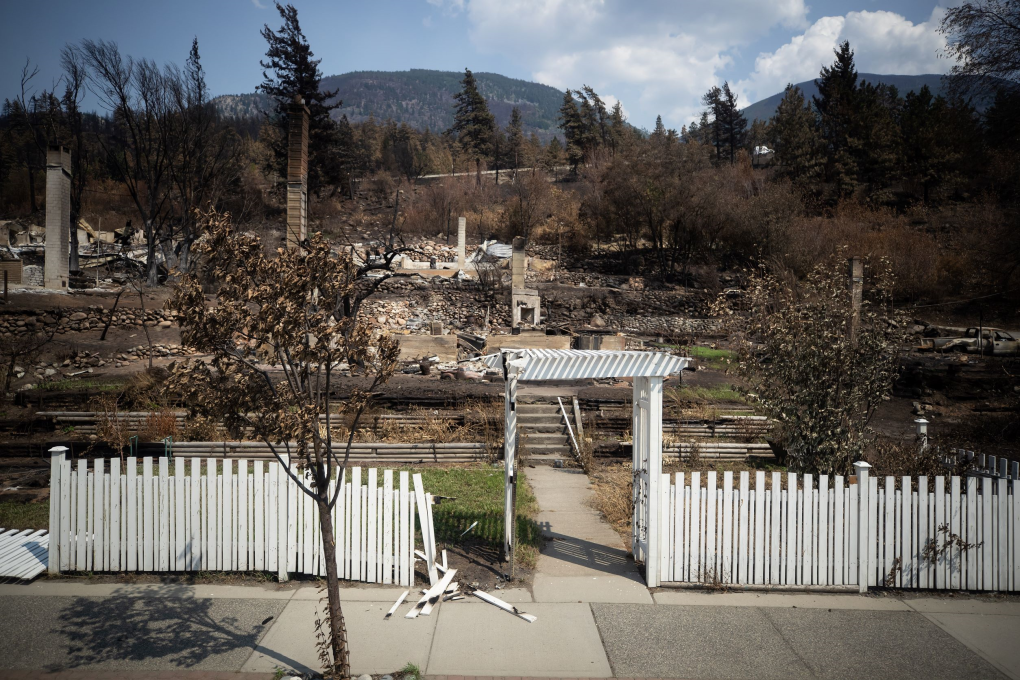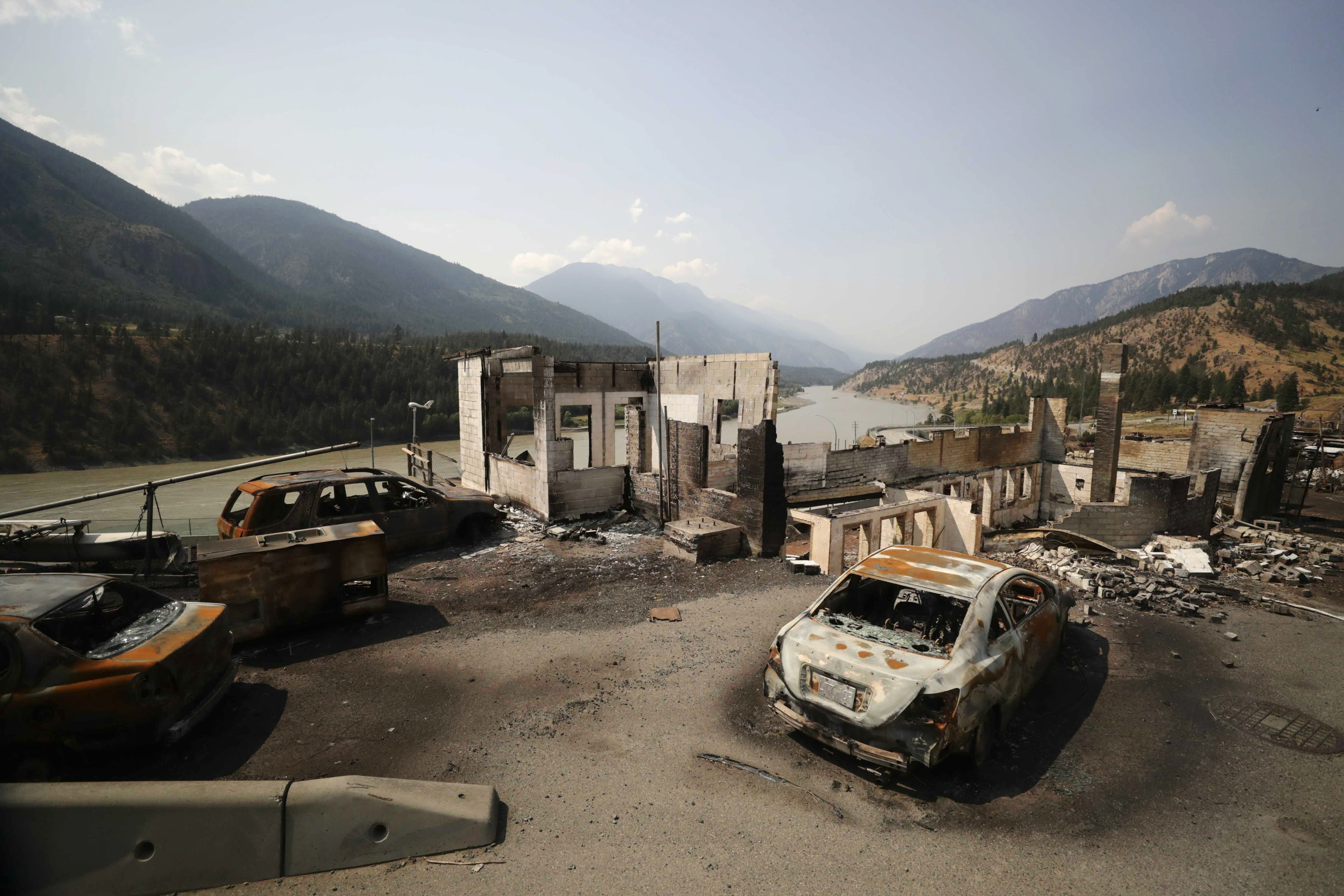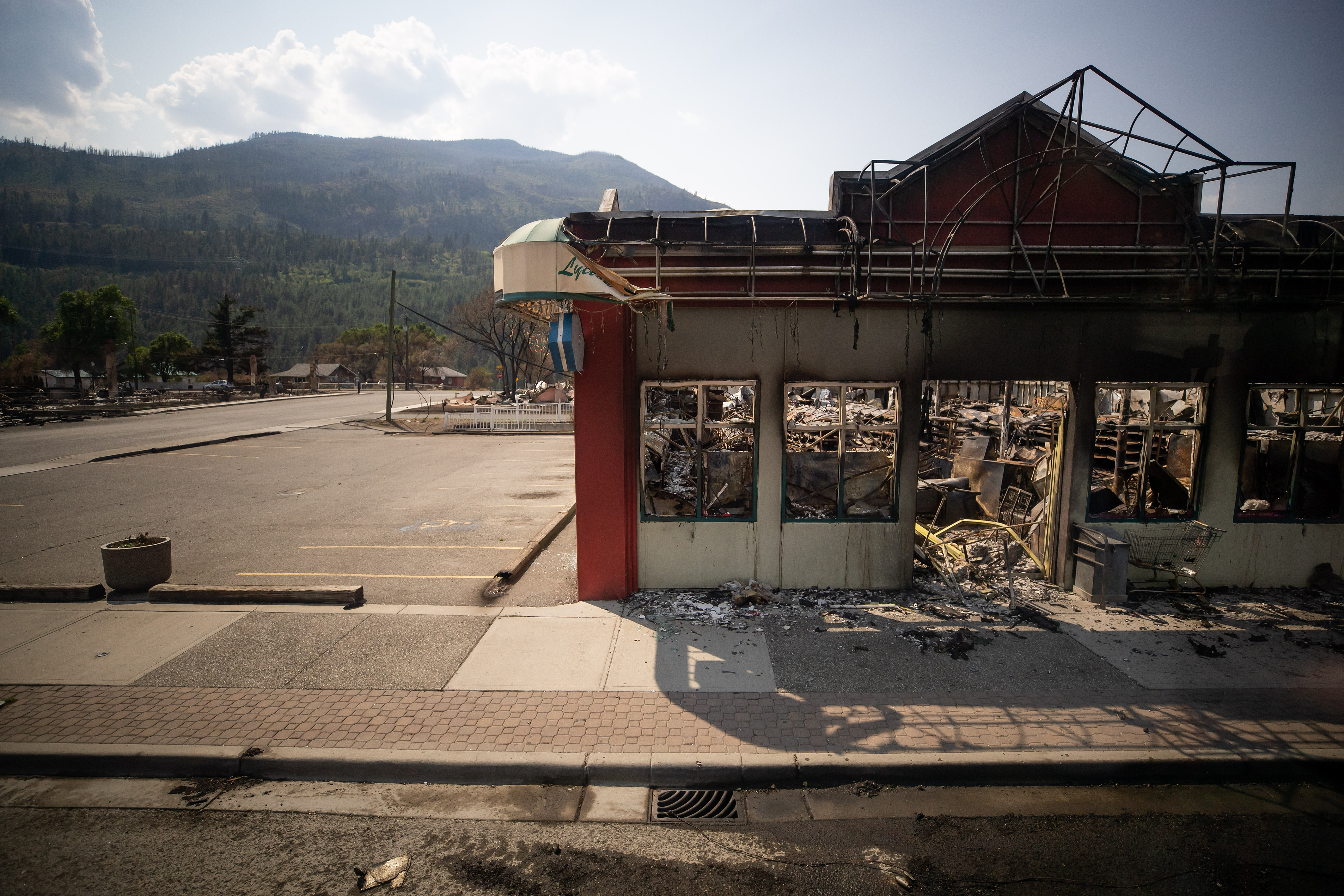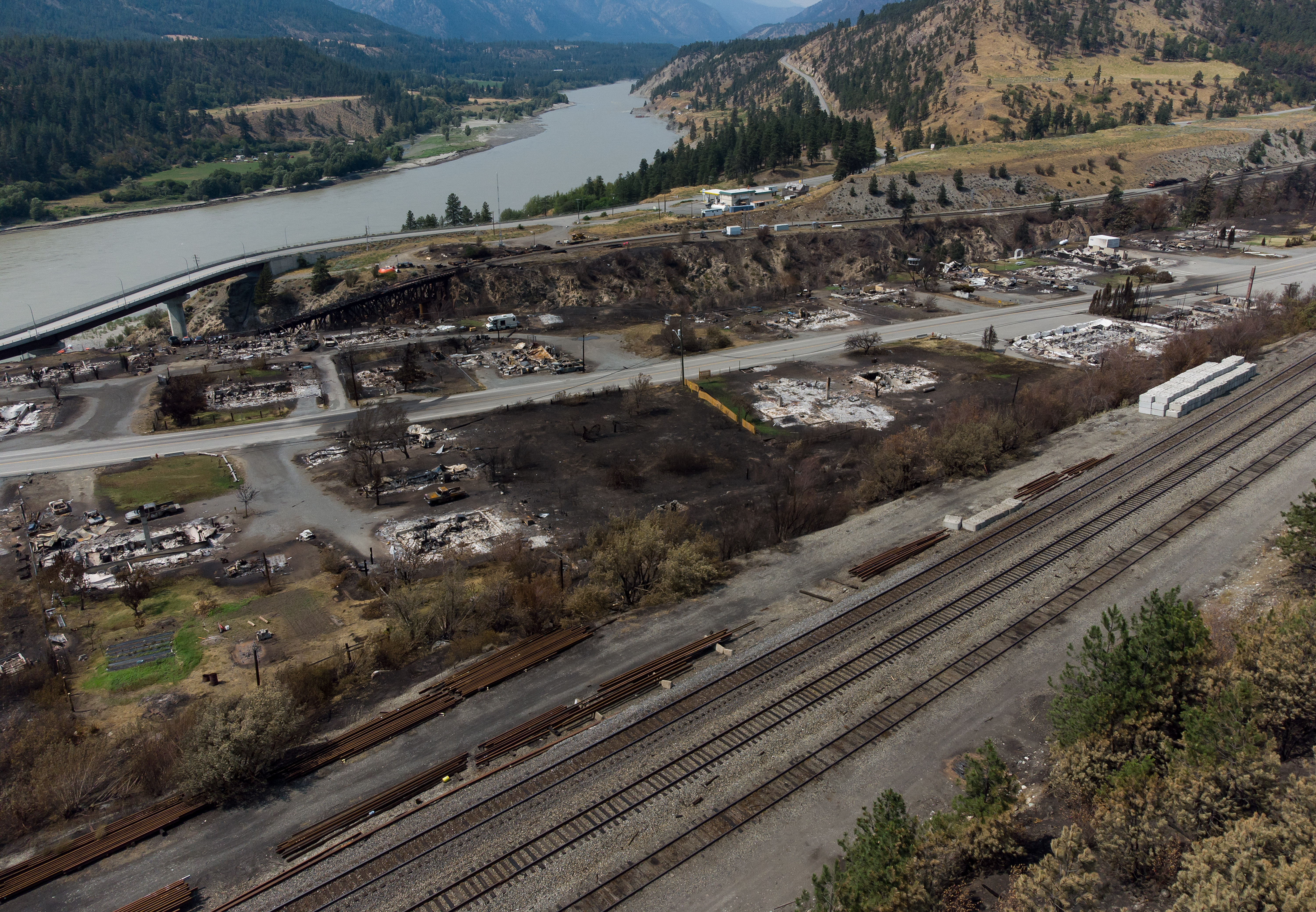Haunting images show devastation in wake of fire that destroyed B.C. village
A B.C. village made headlines late last month for recording the hottest-ever temperatures in the entire country three days in a row.
On the fourth day, the population-250 community burned to the ground.
On June 30, residents had just minutes to grab essential items and leave their homes, which they would never again see in tact.
The cause of the fire has not yet been confirmed, though the Transportation Safety Board of Canada is investigating a possible train fire in the village.
Two people are known to have died. Several were injured.
In the days that followed, some residents were unaccounted for, as the evacuation order came so quickly that people scattered across B.C.'s Interior.
Not allowed to return home for safety reasons, those who'd lost everything may have seen photos and video on social media, or heard statements from the mayor that the majority of their village had been leveled by the fire.
It was not until July 9, nine days after the fire, that they were able to see the damage in person, on a bus tour through what remained of the village.
A media tour followed that bus. Images from The Canadian Press photojournalist Darryl Dyck show what those residents saw of what had been their home.
 Damaged structures are seen in Lytton, B.C., on Friday, July 9, 2021, after a fire destroyed most of the village on June 30. (Darryl Dyck / THE CANADIAN PRESS)
Damaged structures are seen in Lytton, B.C., on Friday, July 9, 2021, after a fire destroyed most of the village on June 30. (Darryl Dyck / THE CANADIAN PRESS)
 Damaged structures are seen in Lytton, B.C., on Friday, July 9, 2021, after a fire destroyed most of the village on June 30. (Darryl Dyck / THE CANADIAN PRESS)
Damaged structures are seen in Lytton, B.C., on Friday, July 9, 2021, after a fire destroyed most of the village on June 30. (Darryl Dyck / THE CANADIAN PRESS)
 Damaged structures are seen in Lytton, B.C., on Friday, July 9, 2021, after a fire destroyed most of the village on June 30. (Darryl Dyck / THE CANADIAN PRESS)
Damaged structures are seen in Lytton, B.C., on Friday, July 9, 2021, after a fire destroyed most of the village on June 30. (Darryl Dyck / THE CANADIAN PRESS)
 Damaged structures are seen in Lytton, B.C., on Friday, July 9, 2021, after a fire destroyed most of the village on June 30. (Darryl Dyck / THE CANADIAN PRESS)
Damaged structures are seen in Lytton, B.C., on Friday, July 9, 2021, after a fire destroyed most of the village on June 30. (Darryl Dyck / THE CANADIAN PRESS)
 Damaged structures are seen in Lytton, B.C., on Friday, July 9, 2021, after a fire destroyed most of the village on June 30. (Darryl Dyck / THE CANADIAN PRESS)
Damaged structures are seen in Lytton, B.C., on Friday, July 9, 2021, after a fire destroyed most of the village on June 30. (Darryl Dyck / THE CANADIAN PRESS)
 Damaged structures are seen in Lytton, B.C., on Friday, July 9, 2021, after a fire destroyed most of the village on June 30. (Darryl Dyck / THE CANADIAN PRESS)
Damaged structures are seen in Lytton, B.C., on Friday, July 9, 2021, after a fire destroyed most of the village on June 30. (Darryl Dyck / THE CANADIAN PRESS)
 Damaged structures are seen in Lytton, B.C., on Friday, July 9, 2021, after a fire destroyed most of the village on June 30. (Darryl Dyck / THE CANADIAN PRESS)
Damaged structures are seen in Lytton, B.C., on Friday, July 9, 2021, after a fire destroyed most of the village on June 30. (Darryl Dyck / THE CANADIAN PRESS)
 Damaged structures are seen in Lytton, B.C., on Friday, July 9, 2021, after a fire destroyed most of the village on June 30. (Darryl Dyck / THE CANADIAN PRESS)
Damaged structures are seen in Lytton, B.C., on Friday, July 9, 2021, after a fire destroyed most of the village on June 30. (Darryl Dyck / THE CANADIAN PRESS)
 Damaged structures are seen in Lytton, B.C., on Friday, July 9, 2021, after a fire destroyed most of the village on June 30. (Darryl Dyck / THE CANADIAN PRESS)
Damaged structures are seen in Lytton, B.C., on Friday, July 9, 2021, after a fire destroyed most of the village on June 30. (Darryl Dyck / THE CANADIAN PRESS)
 Damaged structures are seen in Lytton, B.C., on Friday, July 9, 2021, after a fire destroyed most of the village on June 30. (Darryl Dyck / THE CANADIAN PRESS)
Damaged structures are seen in Lytton, B.C., on Friday, July 9, 2021, after a fire destroyed most of the village on June 30. (Darryl Dyck / THE CANADIAN PRESS)
 Damaged structures are seen in Lytton, B.C., on Friday, July 9, 2021, after a fire destroyed most of the village on June 30. (Darryl Dyck / THE CANADIAN PRESS)
Damaged structures are seen in Lytton, B.C., on Friday, July 9, 2021, after a fire destroyed most of the village on June 30. (Darryl Dyck / THE CANADIAN PRESS)
 Damaged structures are seen in Lytton, B.C., on Friday, July 9, 2021, after a fire destroyed most of the village on June 30. (Darryl Dyck / THE CANADIAN PRESS)
Damaged structures are seen in Lytton, B.C., on Friday, July 9, 2021, after a fire destroyed most of the village on June 30. (Darryl Dyck / THE CANADIAN PRESS)
 Damaged structures are seen in Lytton, B.C., on Friday, July 9, 2021, after a fire destroyed most of the village on June 30. (Darryl Dyck / THE CANADIAN PRESS)
Damaged structures are seen in Lytton, B.C., on Friday, July 9, 2021, after a fire destroyed most of the village on June 30. (Darryl Dyck / THE CANADIAN PRESS)
 Damaged structures are seen in Lytton, B.C., on Friday, July 9, 2021, after a fire destroyed most of the village on June 30. (Darryl Dyck / THE CANADIAN PRESS)
Damaged structures are seen in Lytton, B.C., on Friday, July 9, 2021, after a fire destroyed most of the village on June 30. (Darryl Dyck / THE CANADIAN PRESS)
 Damaged structures are seen in Lytton, B.C., on Friday, July 9, 2021, after a fire destroyed most of the village on June 30. (Darryl Dyck / THE CANADIAN PRESS)
Damaged structures are seen in Lytton, B.C., on Friday, July 9, 2021, after a fire destroyed most of the village on June 30. (Darryl Dyck / THE CANADIAN PRESS)
 Damaged structures are seen in Lytton, B.C., on Friday, July 9, 2021, after a fire destroyed most of the village on June 30. (Darryl Dyck / THE CANADIAN PRESS)
Damaged structures are seen in Lytton, B.C., on Friday, July 9, 2021, after a fire destroyed most of the village on June 30. (Darryl Dyck / THE CANADIAN PRESS)
CTVNews.ca Top Stories

'Why would I box myself in?': Singh on why he won't commit to helping bring Trudeau's gov't down, yet
NDP Leader Jagmeet Singh says U.S. president-elect Donald Trump's looming tariff threat is part of the reason why he's not committing to voting non-confidence in Prime Minister Justin Trudeau's government.
Donald Trump says Canada becoming 51st U.S. state is 'a great idea.' Jean Charest calls the comment a 'wake-up call'
U.S. President-elect Donald Trump is taking aim at Canada once more, saying it would be 'a great idea' to make it America's ‘51st state.'
B.C. man drops camera into ocean, accidentally captures 'breathtaking' whale video
Before it turned into an extraordinary day, Peter Mieras says it began being quite ordinary.
Elon Musk comes out swinging against government spending package in early test of his political might
Elon Musk derided a Republican-backed government spending bill that if not passed by Friday night would lead to a government shut down.
Police suspect Utah father killed his wife and 3 kids, wounded son, then killed himself
Five people were found dead in a Utah home after a man apparently shot his wife and four children before killing himself, police said Wednesday. A 17-year-old boy survived but has a severe brain injury.
Invasive 'murder hornets' are wiped out in the U.S., officials say
The world's largest hornet, an invasive breed dubbed the “murder hornet” for its dangerous sting and ability to slaughter a honey bee hive in a matter of hours, has been declared eradicated in the U.S., five years after being spotted for the first time in Washington state near the Canadian border.
'An enormous problem': Court delays plague criminal cases across the country
Legal delays are making it increasingly difficult for people to have their day in court. One Saskatoon family says they missed out on justice after delays forced the judge to stay proceedings in an impaired driving case that killed their daughter.
What's the best treatment for ADHD? Large new study offers clues
Stimulant medications and certain therapies are more effective in treating ADHD symptoms than placebos, a new study on more than 14,000 adults has found.
'It's a giant mess': Confusion remains about the GST/HST holiday
The organization representing small and medium size businesses in Canada says the start to the GST and HST holiday has been 'a giant mess.'

































